Need a new (used) car - Considering a Saab 9-3 Aero
Discussion
There's no reason at all NOT to consider one.
Go for a 2004 model - you will avoid the SAI issues the 2003 only had (only fitted that year).
Here's a review and more of our 9-3SS Aero I first wrote around 2 years ago, and an update.
The car now has 98000 on the clock around 18 months on. Still going strong, and bringing a smile or several to my face.

2003 - SAAB 9-3 Aero - a personal review.
ABOUT THE AUTHOR
Co-founder of Great Western Saabs.
I have owned three 9000's - 2.3CSE FBT, 3.0CSE V6, and, currently a 2.3t Anniversary, two GM900's - 2.0 Turbo Convertible, and XS (which my daughter now has), currently, and forever, a 96, and the vehicle reviewed here. I have also driven various other 9000's, classic 900's, 9-5's, although not the current one, and classic 9-3's.
INTRODUCTION
The 9-3 Aero reviewed was purchased through the trade, in January 2011, one private owner since new, and having covered 78,000 miles. The car has a full service history, all handbooks and the accompanying wallet, two key fobs, plus a huge file of paperwork. The previous owner was obviously fastidious. This review reflects the personal views and opinions of the author after 6 weeks of ownership.
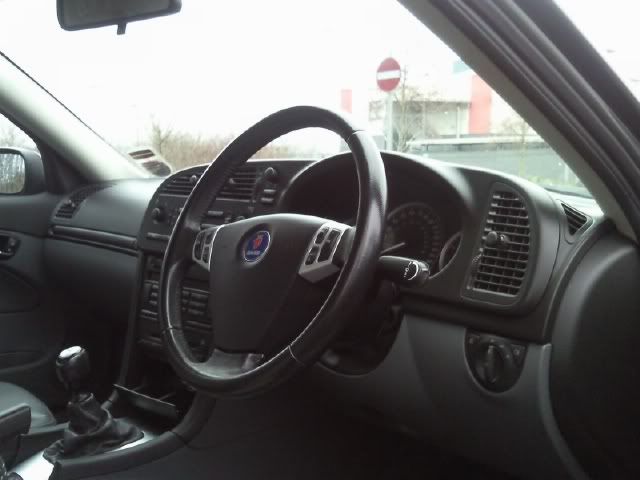
A sense of well-being.
FIRST IMPRESSIONS
Sitting for the first time in the driver’s seat of the 9-3, you are left no doubt that you are at the wheel of a Saab, even if the Saab Aero decals on the sills and the badge on the steering wheel give the game away. Missing are the familiar instrument binnacle, dashboard and readouts that lightly evolved from the 900, through to the early 9-5’s. This is a modern Saab. The 9-3’s instruments are very clearly laid out, and as with all Saabs, switchgear live in familiar locations. Sensible, ergonomic, and sound. So Saab. There is a large feeling of space in sitting in the cockpit, and a huge sense of well-being, too. This car has something special.

Inviting seats.
SEATING
The front seats are very comfortable, and supportive - possibly the most comfortable in a Saab I have owned - and are trimmed in half leather. The central part of the cushions and backs of the seats are covered with a very strong, ivory-coloured fabric, contrasting grey leather elsewhere. This makes sense when you consider wear and tear, and eliminates the need for heated seats – available as an option. The driver sits directly in front of the steering wheel and pedals – not to one side. The steering wheel has good fore and aft adjustment, too. Head and leg room is excellent in both the front and rear. There are also small pockets to the front of both passenger and driver seats – very useful – and much larger at the rear. Lumbar, in and out, and height adjustment – via a pumped handle, cf. the GM900 - means that drivers of all shapes and sizes ought to be able to find a comfortable driving position. In this example, this is manually achieved. Electrically operated and memory seats were also an option.
REFINEMENTS, COMFORTS AND TOYS
The Aero is equipped with ESP (Electronic Stability Control), ABS, EBD, air-bags all round, active headrests, and three-point seatbelts that are pre-tensioned. It also has a 5 star NCAP safety rating.
Easy entry to the Aero is gained via an electronic key/fob hybrid, purely by remote control. The fob has the usual buttons for (deadlock) doors lock, doors unlock, boot release, and a fourth, to activate the interior lighting and sidelights – handy if you have used a dark car park. The ignition barrel is again sited in the Centre Console, behind the gear lever, which does not need to be placed in Reverse to remove the key.
Mention has been made of inferior plastics used by some articles. They are perfectly OK, functional, clean and hard wearing, and, most importantly, easy to maintain, and keep clean.
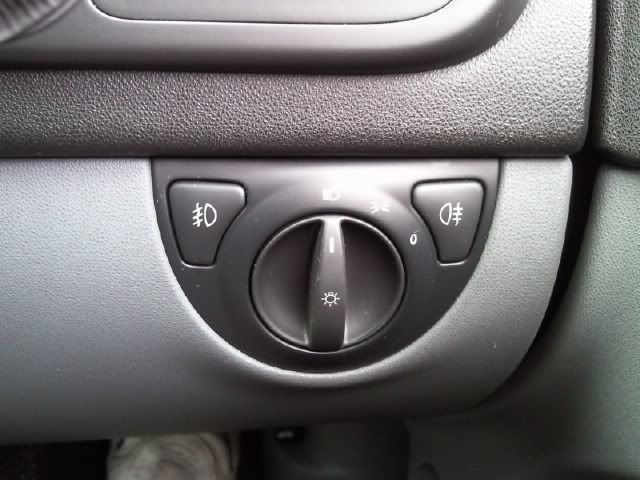
Better headlight, rear and foglight control
Some switchgear have been moved to more sensible positions. The switch for headlights and sidelights has been moved to a lower position to the right of the dashboard, and operates anti-clockwise. Small switches for the Rear and Front Fog lights are now placed to the top of this and are no longer hidden by the steering wheel. Overall buttons for the electric windows have been moved from the Centre Console to the driver’s door, the other doors have their own buttons, and, door lock/unlock switches. There is the usual boot flip switch, but a switch for remote filler cap operation has been lost.
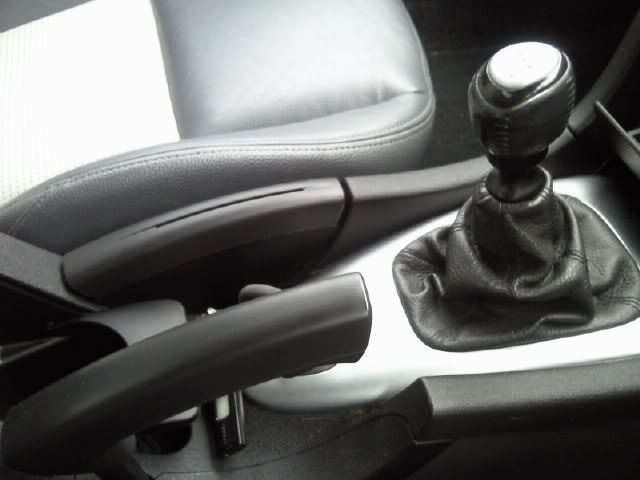
Stylised handbrake.
The Centre Console itself has had a clever makeover. It is dominated, for the most part, by a stylised handbrake lever, the button for operation works using the index and third finger. The passenger has a cup holder, and they will be amused as it performs its choreography, when operated from the dashboard.
To the rear of the Centre Console is a small, covered storage box, inside which, lives a retractable cup holder for the driver. Behind this, is a larger storage box below an arm rest, having a 12 volt output, and a blanking socket for MP3 plug-ins – again an option. To the front of the gear lever is a further storage area for sunglass-cased sized objects. This lives below an ashtray that slides forward for use. The Central Console is trimmed in brushed aluminium, looking very attractive. Both front and rear passengers have the dome lighting, plus individually operated reading lights. There is a large drop-down glove box, which has the option to be refrigerated.
Rear seat passengers have headrests, and the usual retractable armrest, which incorporates a ski hatch, ashtray and cigar lighter and a retractable twin cup holder, housed in the bottom on the rear seats. The rear seats can be folded down, to increase boot space further from its capable 425 litre capacity.
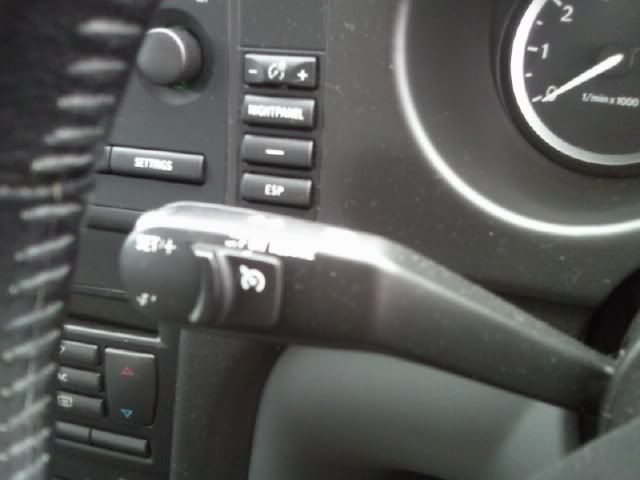
Indicator/Main Beam/Cruise Control stalk.
The indicator/main beams stalk to the left of the steering column, also has the cruise control fitted and its operation is far more positive, and easier to use, than those on previous Saabs. The wash wipe stalk to the right has 2 speeds, plus intermediate, and the windscreen wash also operated from here has a powerful 3x twin spray, whilst the headlights themselves are also power-washed. Rain-sensitive wipers are an option.
DASHBOARD
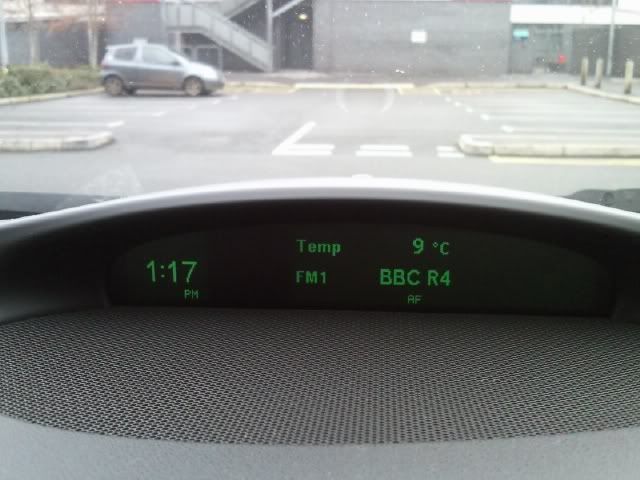
The SID readout.
The SID readout has been moved to atop of the dashboard, and is far more comprehensive than that found in the GM900 and 9-3. There are many categories to customise – Air Conditioning, Alarms, Speed Alarms, and more. This new location is not intrusive. All readouts are in clearly described in green. There is a separate digital clock to the left, while the top line of the SID shows the read-out for the many computer functions – here the outside temperature. The bottom line indicates either the Radio or CD displays. The display is not a distraction while on the road.
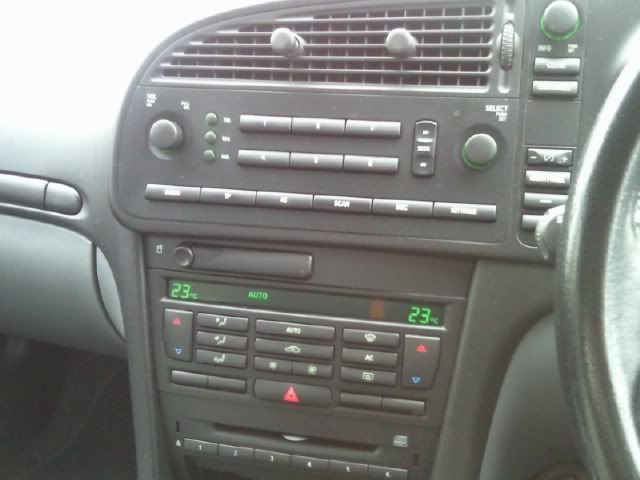
Radio, Heater and 6CD
The controls for the radio are found below the central air vents, are large, and easily described. The 6-CD changer is integral to the unit, and sits beneath the heater controls.
All heater controls are simple and easy to use, and less ambiguous than that found with the 9000 with ACC. They can either be set to individual tastes, or revert to the factory option, which works well, and quickly, on cold mornings. Heating is split, so that passenger and driver can enjoy different temperature environments.
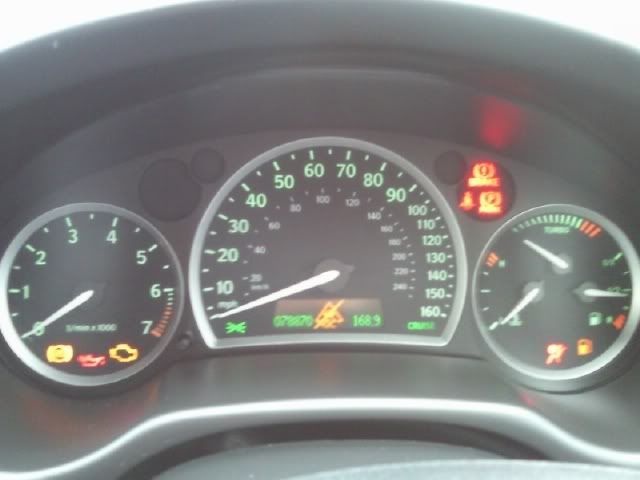
Instrument Binnacle
There are plenty of warning lights in the instrument binnacle, in addition to information gained via the SID. The rev-counter sits to the left, and is sympathetically smaller to the speedometer, which sits large and bold in the middle. Fuel, temperature and turbo gauges sit to the right. The displays are clear, easy to read, and well illuminated, without reflections, as are all the switchgear, in a soft green.
The steering wheel has incorporated controls for volume, preset radio stations, and CD/track operation, which are illuminated, as well as Bluetooth controls, should a phone be required - but only a Saab phone.

Behind the wheel
BEHIND THE WHEEL
The 9-3 Aero is, without question, a very easy, reassuring and simple car to drive. On starting, there is a slight delay, as the electronic steering wheel lock deactivates, and systems fire up, but once turned over, the car idles almost imperceptibly. The engine is a shorter stroke of the 2.2 Ecotec, found typically in the Omega, Vectra and VX220, and aluminium in structure. Engine management, however, is pure Saab.
The clutch is very light and has a good, not excessive, travel. Gear changes are said by some to be notchy. I would say it is more a positive throw.
This is a six-speed model, and the close gear ratios are ideally appointed, happy to cruise around town in 4th gear at 30mph at c.1500 rpm. 70mph on motorways in 6th shows just over 2000, and care needs to be taken not to exceed the legal limit. Outstandingly stable at speed, the Aero remains quiet, except for some tyre roar. Such is the power and torque available at any speed, the car would be usually driven with care, and a feather-light touch. This is very pleasant and comforting, knowing that there is so much more power and torque in reserve. Motorway travelling easily troubles 40mpg, and to date, the worst returned in solid city work is very slightly less than 30. At present, with trips to work, over 35mpg is registered by SID.
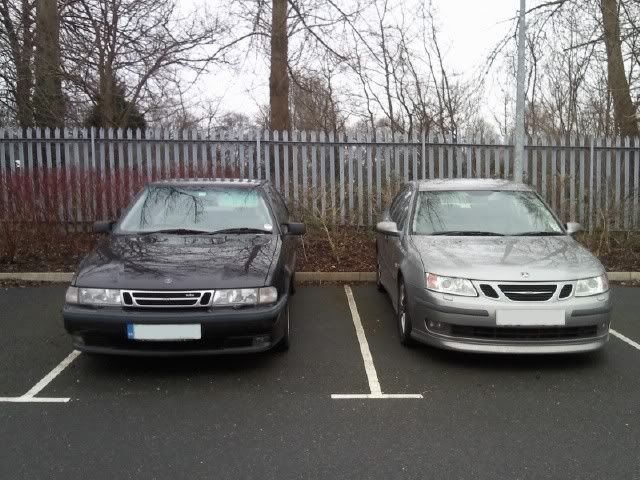
9000 anniversary and the 9 [sup]3[/sup] Aero.
ON THE ROAD
Progress is swift, without drama or fuss. On country roads, overtaking is achieved with ease, if need be, but the Aero is quite happy to potter along, when there is no alternative. Ample torque is always there, already reported for duty, again thanks to the ratios making good use of peak output. The Aero is a free-revving lump, and its high performance can embarrass others on the road. Without its Aero body kit, this would be an ideal Q car.
The electrically operated, variable-assist steering is light at slow speeds, and provides enough feedback to the driver. This is little changed at speed, where assistance is reduced. The Aero has a stability system that slightly ‘steers’ the rear wheels, and undoubtedly helps the handling further. The Aero will corner flat at surprising speeds, and the contoured seats restrain sideways movement. The assisted brakes are powerful, and require little effort.
The car sits on 17 inch ALU50, five-spoke, twin Aero low profile alloys. As a consequence of this, and the spring set up – the Aero sits 10mm lower than the rest of the range - the ride is harsh. It could be argued that this is a symptom of the state of our roads at this time. It is not so intrusive, and if driving style is adapted to compensate, then this is something that one can easily become accustomed to. The low profile tyres originally fiited were sensitive to poor road surfaces, and would tram-line, if caught off-guard, on the worst. The Falken tyres now fitted all around have illiminated this.
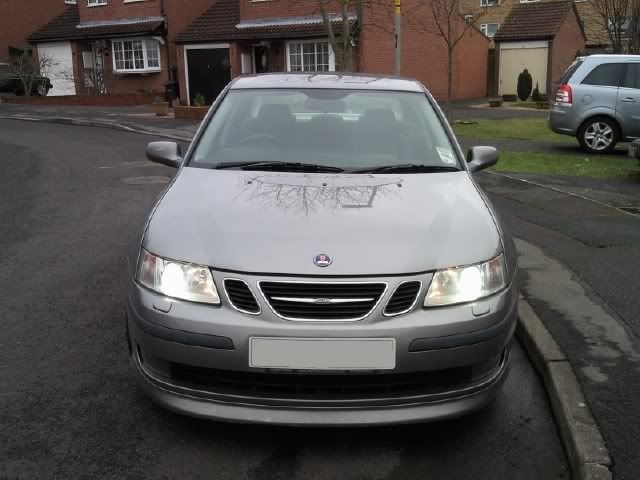
Xenon Headlights
When night falls, the Xenon headlights work powerfully - the main beams even moreso - and for me, are a revelation. The dashboard and readouts are illuminated very well and clearly with no glare; this adjustable, together with Saab’s Night Panel switch - the speedometer can also be lit to show miles or kilometres per hour. All switchgear on the console, dashboard and doors do not reflect in screens or windows.

WHAT TO LOOK FOR
MY OWN EXPERIENCES
The car is very easy to work on.
Expect to replace the front tyres every 13,000 miles, regardless of how heavy/light your right foot is. Also make sure that the tyres have the correct load rating. I will try to get Uniroyals next time.
Rear Brake Pads will also need regular replacement due to the assisted rear steer system. They wear slightly quicker than would otherwise be expected. WARNING - to remove pads you will need to screw in and out the callipers in the opposite way from the rest of the world. You will also need a special tool. Do not buy the one fit tool that says it fits Saabs like the below - it [color=red]does not[/color] fit all of them

I bought the whole kit - a very wise investment from Screwfix, for the fleet, and the family. Recommended.

The SAI valve will need to be regularly checked, and cleaned if getting very dirty– a very simple job. If it blocks completely over time, then you will need to replace the secondary air pump, in addition to the valve.
The Saab 9-3 has two washer pumps – one for the headlights, one for the windscreen. Due to their location deep in the nearside front wing, away from any heat source, they can freeze in winter, and you will burn out the motor if used. So a good strength anti-freezing screen wash is adviseable.
The integrated remote/key fob can fall apart, but replacements are available.
Stability control issue – a rogue failure warning may show on SID, especially after reversing around a corner. Many examples do this. Just clear it and move on. It is over sensitive.
Plenty of spare parts easily available either secondhand or new. A new Saab Parts company, a separate concern from SAAB/NEVS, is up and running, and guaranteed, in its remit, to be around for years to come. Following the car being the victim of a hit and run in a Supermarket car park, a rear door was secured in matching paint code, complete for just £50. Replacement took all of 15 minutes!
IT IS SAID
Alternators may fail.
Front springs may fail – widely known, but no worse than any other car. Issue blown out of proportion.
The five speed is preferable over the six, for strength and drivability. Well, only if you change gears like a power-lifter, I would suggest, and this only applies to the most earliest of cars, but I can see what is got at.
Check that all the electrical toys work, as you would with any other car. There have been no failures, to date.
The head unit can be upgraded to another, superior Saab unit, but will need a Tech II to marry it. While you're doing that, you may be thinking of additional speakers, possibly replacing the stock ones, too, and slipping in an amplifier.
Recalls affecting US cars, IIRC.
2005 – leak from fuel pump
2005 – front seat belt issue
2006 – rear hub
2006 – check of braking performance
2007 - handbrake
THE FUTURE
To replace the speakers and install additions.
TALE OF THE TAPE
0-60 mph: 7.3 seconds
Top speed: 146mph
BHP: 210@6000rpm
Torque: 221@2500rpm
Length (cm): 462.9
Width (cm): 201.1 - includes door mirrors
Weight (Kgs): 1465
Wheelbase: 267.5 cm
Fuel Tank: 58 litres
Turning Circle: 10 metres
Unbraked/braked towing weights: 750Kgs. /1600Kgs.
HTH!
Go for a 2004 model - you will avoid the SAI issues the 2003 only had (only fitted that year).
Here's a review and more of our 9-3SS Aero I first wrote around 2 years ago, and an update.
The car now has 98000 on the clock around 18 months on. Still going strong, and bringing a smile or several to my face.

2003 - SAAB 9-3 Aero - a personal review.
ABOUT THE AUTHOR
Co-founder of Great Western Saabs.
I have owned three 9000's - 2.3CSE FBT, 3.0CSE V6, and, currently a 2.3t Anniversary, two GM900's - 2.0 Turbo Convertible, and XS (which my daughter now has), currently, and forever, a 96, and the vehicle reviewed here. I have also driven various other 9000's, classic 900's, 9-5's, although not the current one, and classic 9-3's.
INTRODUCTION
The 9-3 Aero reviewed was purchased through the trade, in January 2011, one private owner since new, and having covered 78,000 miles. The car has a full service history, all handbooks and the accompanying wallet, two key fobs, plus a huge file of paperwork. The previous owner was obviously fastidious. This review reflects the personal views and opinions of the author after 6 weeks of ownership.

A sense of well-being.
FIRST IMPRESSIONS
Sitting for the first time in the driver’s seat of the 9-3, you are left no doubt that you are at the wheel of a Saab, even if the Saab Aero decals on the sills and the badge on the steering wheel give the game away. Missing are the familiar instrument binnacle, dashboard and readouts that lightly evolved from the 900, through to the early 9-5’s. This is a modern Saab. The 9-3’s instruments are very clearly laid out, and as with all Saabs, switchgear live in familiar locations. Sensible, ergonomic, and sound. So Saab. There is a large feeling of space in sitting in the cockpit, and a huge sense of well-being, too. This car has something special.

Inviting seats.
SEATING
The front seats are very comfortable, and supportive - possibly the most comfortable in a Saab I have owned - and are trimmed in half leather. The central part of the cushions and backs of the seats are covered with a very strong, ivory-coloured fabric, contrasting grey leather elsewhere. This makes sense when you consider wear and tear, and eliminates the need for heated seats – available as an option. The driver sits directly in front of the steering wheel and pedals – not to one side. The steering wheel has good fore and aft adjustment, too. Head and leg room is excellent in both the front and rear. There are also small pockets to the front of both passenger and driver seats – very useful – and much larger at the rear. Lumbar, in and out, and height adjustment – via a pumped handle, cf. the GM900 - means that drivers of all shapes and sizes ought to be able to find a comfortable driving position. In this example, this is manually achieved. Electrically operated and memory seats were also an option.
REFINEMENTS, COMFORTS AND TOYS
The Aero is equipped with ESP (Electronic Stability Control), ABS, EBD, air-bags all round, active headrests, and three-point seatbelts that are pre-tensioned. It also has a 5 star NCAP safety rating.
Easy entry to the Aero is gained via an electronic key/fob hybrid, purely by remote control. The fob has the usual buttons for (deadlock) doors lock, doors unlock, boot release, and a fourth, to activate the interior lighting and sidelights – handy if you have used a dark car park. The ignition barrel is again sited in the Centre Console, behind the gear lever, which does not need to be placed in Reverse to remove the key.
Mention has been made of inferior plastics used by some articles. They are perfectly OK, functional, clean and hard wearing, and, most importantly, easy to maintain, and keep clean.

Better headlight, rear and foglight control
Some switchgear have been moved to more sensible positions. The switch for headlights and sidelights has been moved to a lower position to the right of the dashboard, and operates anti-clockwise. Small switches for the Rear and Front Fog lights are now placed to the top of this and are no longer hidden by the steering wheel. Overall buttons for the electric windows have been moved from the Centre Console to the driver’s door, the other doors have their own buttons, and, door lock/unlock switches. There is the usual boot flip switch, but a switch for remote filler cap operation has been lost.

Stylised handbrake.
The Centre Console itself has had a clever makeover. It is dominated, for the most part, by a stylised handbrake lever, the button for operation works using the index and third finger. The passenger has a cup holder, and they will be amused as it performs its choreography, when operated from the dashboard.
To the rear of the Centre Console is a small, covered storage box, inside which, lives a retractable cup holder for the driver. Behind this, is a larger storage box below an arm rest, having a 12 volt output, and a blanking socket for MP3 plug-ins – again an option. To the front of the gear lever is a further storage area for sunglass-cased sized objects. This lives below an ashtray that slides forward for use. The Central Console is trimmed in brushed aluminium, looking very attractive. Both front and rear passengers have the dome lighting, plus individually operated reading lights. There is a large drop-down glove box, which has the option to be refrigerated.
Rear seat passengers have headrests, and the usual retractable armrest, which incorporates a ski hatch, ashtray and cigar lighter and a retractable twin cup holder, housed in the bottom on the rear seats. The rear seats can be folded down, to increase boot space further from its capable 425 litre capacity.

Indicator/Main Beam/Cruise Control stalk.
The indicator/main beams stalk to the left of the steering column, also has the cruise control fitted and its operation is far more positive, and easier to use, than those on previous Saabs. The wash wipe stalk to the right has 2 speeds, plus intermediate, and the windscreen wash also operated from here has a powerful 3x twin spray, whilst the headlights themselves are also power-washed. Rain-sensitive wipers are an option.
DASHBOARD

The SID readout.
The SID readout has been moved to atop of the dashboard, and is far more comprehensive than that found in the GM900 and 9-3. There are many categories to customise – Air Conditioning, Alarms, Speed Alarms, and more. This new location is not intrusive. All readouts are in clearly described in green. There is a separate digital clock to the left, while the top line of the SID shows the read-out for the many computer functions – here the outside temperature. The bottom line indicates either the Radio or CD displays. The display is not a distraction while on the road.

Radio, Heater and 6CD
The controls for the radio are found below the central air vents, are large, and easily described. The 6-CD changer is integral to the unit, and sits beneath the heater controls.
All heater controls are simple and easy to use, and less ambiguous than that found with the 9000 with ACC. They can either be set to individual tastes, or revert to the factory option, which works well, and quickly, on cold mornings. Heating is split, so that passenger and driver can enjoy different temperature environments.

Instrument Binnacle
There are plenty of warning lights in the instrument binnacle, in addition to information gained via the SID. The rev-counter sits to the left, and is sympathetically smaller to the speedometer, which sits large and bold in the middle. Fuel, temperature and turbo gauges sit to the right. The displays are clear, easy to read, and well illuminated, without reflections, as are all the switchgear, in a soft green.
The steering wheel has incorporated controls for volume, preset radio stations, and CD/track operation, which are illuminated, as well as Bluetooth controls, should a phone be required - but only a Saab phone.

Behind the wheel
BEHIND THE WHEEL
The 9-3 Aero is, without question, a very easy, reassuring and simple car to drive. On starting, there is a slight delay, as the electronic steering wheel lock deactivates, and systems fire up, but once turned over, the car idles almost imperceptibly. The engine is a shorter stroke of the 2.2 Ecotec, found typically in the Omega, Vectra and VX220, and aluminium in structure. Engine management, however, is pure Saab.
The clutch is very light and has a good, not excessive, travel. Gear changes are said by some to be notchy. I would say it is more a positive throw.
This is a six-speed model, and the close gear ratios are ideally appointed, happy to cruise around town in 4th gear at 30mph at c.1500 rpm. 70mph on motorways in 6th shows just over 2000, and care needs to be taken not to exceed the legal limit. Outstandingly stable at speed, the Aero remains quiet, except for some tyre roar. Such is the power and torque available at any speed, the car would be usually driven with care, and a feather-light touch. This is very pleasant and comforting, knowing that there is so much more power and torque in reserve. Motorway travelling easily troubles 40mpg, and to date, the worst returned in solid city work is very slightly less than 30. At present, with trips to work, over 35mpg is registered by SID.

9000 anniversary and the 9 [sup]3[/sup] Aero.
ON THE ROAD
Progress is swift, without drama or fuss. On country roads, overtaking is achieved with ease, if need be, but the Aero is quite happy to potter along, when there is no alternative. Ample torque is always there, already reported for duty, again thanks to the ratios making good use of peak output. The Aero is a free-revving lump, and its high performance can embarrass others on the road. Without its Aero body kit, this would be an ideal Q car.
The electrically operated, variable-assist steering is light at slow speeds, and provides enough feedback to the driver. This is little changed at speed, where assistance is reduced. The Aero has a stability system that slightly ‘steers’ the rear wheels, and undoubtedly helps the handling further. The Aero will corner flat at surprising speeds, and the contoured seats restrain sideways movement. The assisted brakes are powerful, and require little effort.
The car sits on 17 inch ALU50, five-spoke, twin Aero low profile alloys. As a consequence of this, and the spring set up – the Aero sits 10mm lower than the rest of the range - the ride is harsh. It could be argued that this is a symptom of the state of our roads at this time. It is not so intrusive, and if driving style is adapted to compensate, then this is something that one can easily become accustomed to. The low profile tyres originally fiited were sensitive to poor road surfaces, and would tram-line, if caught off-guard, on the worst. The Falken tyres now fitted all around have illiminated this.

Xenon Headlights
When night falls, the Xenon headlights work powerfully - the main beams even moreso - and for me, are a revelation. The dashboard and readouts are illuminated very well and clearly with no glare; this adjustable, together with Saab’s Night Panel switch - the speedometer can also be lit to show miles or kilometres per hour. All switchgear on the console, dashboard and doors do not reflect in screens or windows.

WHAT TO LOOK FOR
MY OWN EXPERIENCES
The car is very easy to work on.
Expect to replace the front tyres every 13,000 miles, regardless of how heavy/light your right foot is. Also make sure that the tyres have the correct load rating. I will try to get Uniroyals next time.
Rear Brake Pads will also need regular replacement due to the assisted rear steer system. They wear slightly quicker than would otherwise be expected. WARNING - to remove pads you will need to screw in and out the callipers in the opposite way from the rest of the world. You will also need a special tool. Do not buy the one fit tool that says it fits Saabs like the below - it [color=red]does not[/color] fit all of them

I bought the whole kit - a very wise investment from Screwfix, for the fleet, and the family. Recommended.

The SAI valve will need to be regularly checked, and cleaned if getting very dirty– a very simple job. If it blocks completely over time, then you will need to replace the secondary air pump, in addition to the valve.
The Saab 9-3 has two washer pumps – one for the headlights, one for the windscreen. Due to their location deep in the nearside front wing, away from any heat source, they can freeze in winter, and you will burn out the motor if used. So a good strength anti-freezing screen wash is adviseable.
The integrated remote/key fob can fall apart, but replacements are available.
Stability control issue – a rogue failure warning may show on SID, especially after reversing around a corner. Many examples do this. Just clear it and move on. It is over sensitive.
Plenty of spare parts easily available either secondhand or new. A new Saab Parts company, a separate concern from SAAB/NEVS, is up and running, and guaranteed, in its remit, to be around for years to come. Following the car being the victim of a hit and run in a Supermarket car park, a rear door was secured in matching paint code, complete for just £50. Replacement took all of 15 minutes!
IT IS SAID
Alternators may fail.
Front springs may fail – widely known, but no worse than any other car. Issue blown out of proportion.
The five speed is preferable over the six, for strength and drivability. Well, only if you change gears like a power-lifter, I would suggest, and this only applies to the most earliest of cars, but I can see what is got at.
Check that all the electrical toys work, as you would with any other car. There have been no failures, to date.
The head unit can be upgraded to another, superior Saab unit, but will need a Tech II to marry it. While you're doing that, you may be thinking of additional speakers, possibly replacing the stock ones, too, and slipping in an amplifier.
Recalls affecting US cars, IIRC.
2005 – leak from fuel pump
2005 – front seat belt issue
2006 – rear hub
2006 – check of braking performance
2007 - handbrake
THE FUTURE
To replace the speakers and install additions.
TALE OF THE TAPE
0-60 mph: 7.3 seconds
Top speed: 146mph
BHP: 210@6000rpm
Torque: 221@2500rpm
Length (cm): 462.9
Width (cm): 201.1 - includes door mirrors
Weight (Kgs): 1465
Wheelbase: 267.5 cm
Fuel Tank: 58 litres
Turning Circle: 10 metres
Unbraked/braked towing weights: 750Kgs. /1600Kgs.
HTH!
Edited by LesKellet on Tuesday 1st January 21:46
Edited by LesKellet on Tuesday 1st January 21:54
Thank you very much for the info! Looks a lovely car.
I know you said about 2003 not being so good buuuuut I'm looking at a 2003 one based near Abingdon on ATrader as it looks really good value.
Whats the impact/likelihood of the "SA1" issue?
How long is a piece of string?
It comes with a 6 month warranty.
I know you said about 2003 not being so good buuuuut I'm looking at a 2003 one based near Abingdon on ATrader as it looks really good value.
Whats the impact/likelihood of the "SA1" issue?
How long is a piece of string?
It comes with a 6 month warranty.
I like the 6 month warranty. Great.
Not much of an impact. The Secondary Air Pump was something Saab added because they were worried about emissions at start up, for the first 2 minutes or so. They needn't have been, and removed it from 2004 on. However, you cannot remove it on 2003 cars, or fit a 2004 on ECU to get around it either. My tester always raves about the emissions as tested - every drop of fuel is burnt - these are efficient, clean and economic lumps (I'll have to post a copy of the readings one day)
The only symptom you will have is a Check Engine Light, and a P0401 code when you plug a code reader into the system (the light can be extinguished just before an MoT, and the tester will be none the wiser.) The CEL will show the time after the next cold start, should you extinguish it with the reader. I carry a code reader around, in any instance.
Keeping the SAI valve clean - a five minute job - on a regular basis is a good idea, to preserve the SAI pump
Best mpg to date 45.7 motorway speeds: Bristol - Leeds - Bristol
Not much of an impact. The Secondary Air Pump was something Saab added because they were worried about emissions at start up, for the first 2 minutes or so. They needn't have been, and removed it from 2004 on. However, you cannot remove it on 2003 cars, or fit a 2004 on ECU to get around it either. My tester always raves about the emissions as tested - every drop of fuel is burnt - these are efficient, clean and economic lumps (I'll have to post a copy of the readings one day)
The only symptom you will have is a Check Engine Light, and a P0401 code when you plug a code reader into the system (the light can be extinguished just before an MoT, and the tester will be none the wiser.) The CEL will show the time after the next cold start, should you extinguish it with the reader. I carry a code reader around, in any instance.
Keeping the SAI valve clean - a five minute job - on a regular basis is a good idea, to preserve the SAI pump
Best mpg to date 45.7 motorway speeds: Bristol - Leeds - Bristol
Edited by LesKellet on Tuesday 1st January 22:37
Edited by LesKellet on Tuesday 1st January 22:38
Its all adding up to a new year car purchase I think...
I just did some quick research and found a thread with pictures showing what to look for and how to check its clean which looks really easy so don't think i'll let it stop me.
Cracking MPG as well for the power.
Although if I did hold on for a couple of months I could stretch to an Alfa 147 GTA....
Thanks again for all your assistance - PH comes good again.
Will post in forum as and when the purchase happens!
Cheers
I just did some quick research and found a thread with pictures showing what to look for and how to check its clean which looks really easy so don't think i'll let it stop me.
Cracking MPG as well for the power.
Although if I did hold on for a couple of months I could stretch to an Alfa 147 GTA....
Thanks again for all your assistance - PH comes good again.
Will post in forum as and when the purchase happens!
Cheers

I have just bought a 2005 9-3 aero and I pretty sure you are going to see a car I looked at. Mechanically everything seemed fine, and for the short time I got with the car (it absolutely hammered it down!!) it all seemed to work. Have a good look at the bodywork, there was a dent on the offside front arch that had gone rusty and to be honest the car looked tired for the given mileage and the price he wanted at the time (£3195).
I did see it as it arrived so they may have fixed the issues, and I know he dropped the price so could be worth a bit more of a haggle!!
Good luck with it, I love mine
I did see it as it arrived so they may have fixed the issues, and I know he dropped the price so could be worth a bit more of a haggle!!
Good luck with it, I love mine

Gassing Station | Saab | Top of Page | What's New | My Stuff




